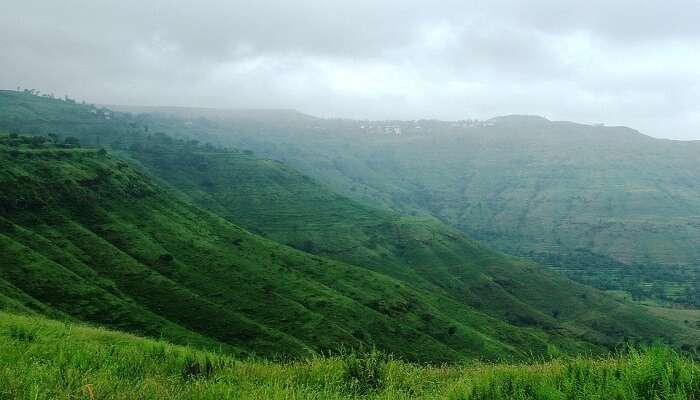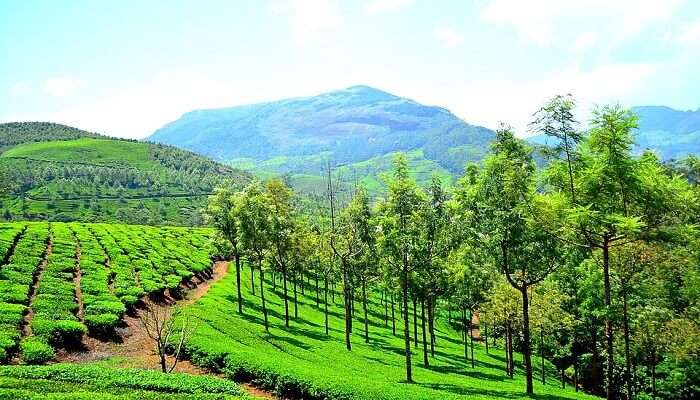Explore Amazing Places To Visit Near Bajra Sandhi Monument In 2025
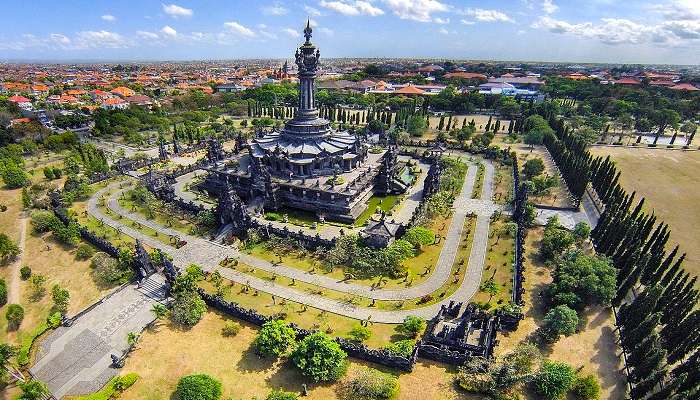
Located in the centre of Denpasar Town, the Bajra Sandhi Monument honours the struggle of the Balinese people and is one of the most visited tourist destinations in Bali. The monument towers over Denpasar town and is shaped like the “bajra,” or praying bell, used by Balinese Hindu priests. This name knows the Bajra Sandhi Monument because of its resemblance to the Bajra, Genta, or bell used by Hindu priests to recite the sacred Weda phrase (mantra) during religious rites.
Places To Visit Near Bajra Sandhi Monument
If you’re visiting the Bajra Sandhi Monument in Bali, you must not miss these fantastic tourist attractions nearby. This blog reveals spiritual retreats to nature’s beauty. Dive into the details of each place and explore the unlimited fun.
1. Puputan Badung Square
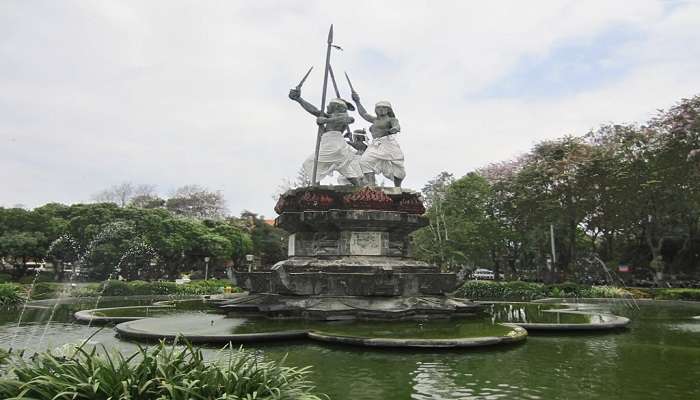
In the centre of Denpasar, Bali, Puputan Badung Square is a historical and cultural relic honouring the courage of Balinese warriors during the Dutch colonial era. One can also learn about the Bajra Sandhi Monument entrance fee. Puputan Badung Square is an ancient core located in Denpasar, Bali. It symbolises Puputan Badung in 1906, the fight of the Balinese royal and their subjects against the Dutch colonial army to death instead of giving up.
Today, in the centre of the square, there is a sculpture that reflects the march of the Balinese royalty to their doom. It is an essential symbol of Bali’s colonial fight because it helps everyone remember the price paid. It also includes many ceremonies and events connected with this history. People come to the square as locals and tourists who want to learn about Bali culture. Thus, Puputan Badung Square symbolises Bali’s historical and cultural centre and struggle against colonisation.
Distance: Approximately 3 km
Highlights: A monument and historical park honouring the Balinese warriors who resisted the Dutch conquerors.
Also Read: Bali In June
2. Art Center Bali
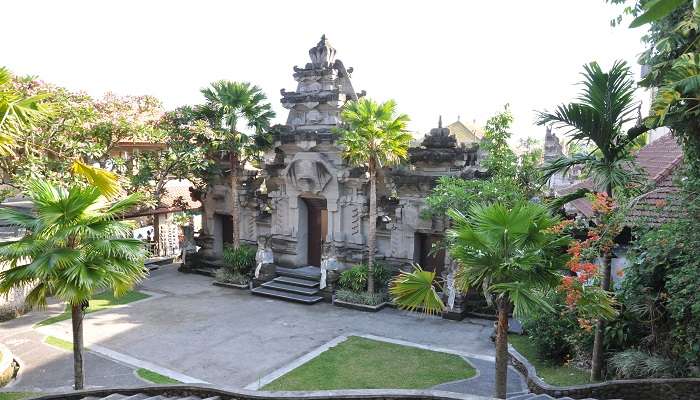
Explore this art center in Bali, also called Taman Budaya Bali, a well-known cultural centre, and learn about the history of the Bajra Sandhi Monument. It was founded in 1973 and acts as a hub for developing and preserving Balinese art and culture. The available pieces of artwork can be categorised into different classes, such as Balinese traditional artwork with religious and spiritual overtones, Balinese contemporary artwork that focuses on day-to-day life events, Balinese modern artwork that is very colourful and abstract, Balinese wooden carving and other Balinese made handicraft products.
It is for temporary exhibitions by invited artists, and the centre is located on the site. It also has art classes, offers practice and performance space for cultural events, and hosts book launches. Art Center Bali presents a glimpse of Bali’s vibrant art scene with a building that has beautiful Balinese-influenced architecture putting into a contemporary twist. One can see beautiful art pieces here, watch artists in action at their studios, and possibly make purchases from the art gallery shop. It is the strategic centre for creativity and where appreciation of Balinese art is cultivated.
Distance: Approximately 2 km
Highlights: Cultural complex that hosts art exhibitions, cultural activities, and traditional dance performances.
3. Pasar Badung
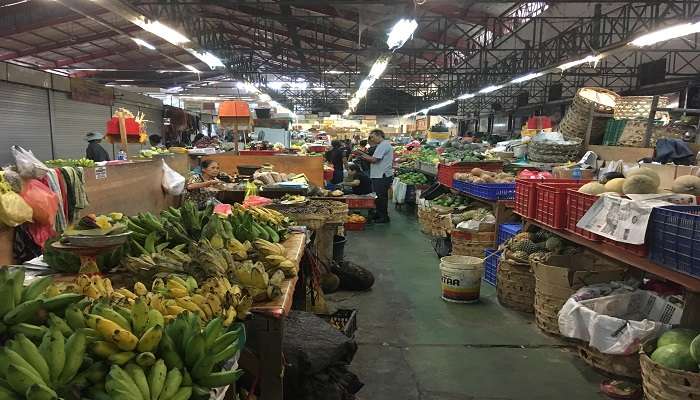
Situated at the centre of Denpasar, Bali, Pasar Badung, near Bajra Sandhi Monument, is the biggest traditional market on the island and a hive of local trade and culture. Pasar Badung is a conventional, large, and popular marketplace for Balinese people in the Denpasar city of Bali in Indonesia. It is the largest traditional market in Cyprus, with more than 500 shops. It is a colourful market that sells almost everything, including fruits, vegetables, spices, dried foods, clothes, and souvenir items. Entering the crowded stalls, which sell all sorts of fruits, different kinds of incense, and other spices, you can breathe in the smell of the products being sold. Street vendors, for instance, gladly shout the prices of their goods to lure the consumer.
The stands of various fruits and vegetables, as well as other food items and merchandise wrapped in the lights of vivid colours, really make an eye appeal. If you are interested in shopping and looking for an avenue that is as local as possible, then you should check out Pasar Badung. Just strolling through the labyrinths of stands is an attack on all senses – the sight gets dazzled by colours, the smell gets overwhelmed by smells, the hearing is surrounded by the constant hum of people and the vendors’ calls and the feeling of continuous movement and the energy of Balinese culture that permeates the exhibition. Being able to offer exclusively selling goods at the most affordable prices, Pasar Badung market guarantees an exciting shopping experience that will make each buyer feel like they are taking home a part of faithful Bali.
Distance: Approximately 4 km
Highlights: Denpasar’s most significant traditional market, where you can buy fresh food, spices, and trinkets while tasting local culture.
Related Post: Best Restaurants In Bali
4. Jagatnatha Temple
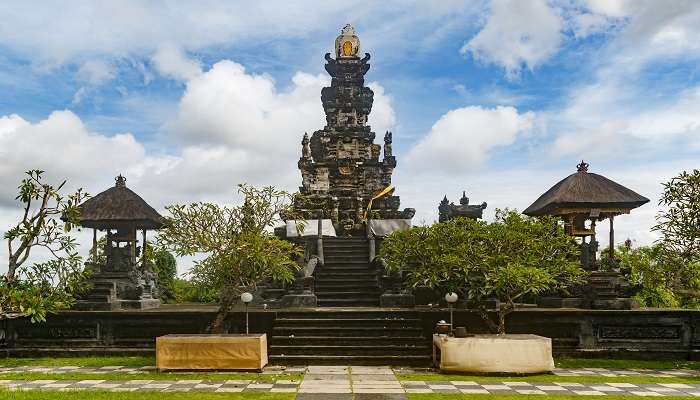
As you know about the Bajra Sandhi Monument opening hours, the other one is Sanghyang Widi Wasa, the highest deity in Balinese Hinduism, is the subject of the religious and cultural monument known as Jagatnatha Temple, which is located in Denpasar, Bali. Jagatnatha temple, also known as Besakih Temple, is situated in Denpasar, Bali. It is an important temple for Hindus and is devoted to Lord Vishnu. It has a rather particular three-story gate tower with red-brick construction that dates back to the 16th century. Unlike the outer area of the temple, which is open to everyone, in the inner court, only Hindus are permitted, and there is a colossal statue of Vishnu.
As one of the six significant ‘Sad Kahyangan’ temples that are seen to tie Bali down spiritually, the Jagatnatha Temple has an essential place in Balinese Hinduism. During the temple festivals, colourful and musical rallies are performed, which are fascinating not only for the people who are devotees but also for the tourists. However, the architectural design of Jagatnatha Temple offers cultural significance as it combines some of the ancient Java-Hindu architectural designs with those of Balinese origin. Temple, therefore, still plays an important role in the cultural fabric of Denpasar city.
Distance: Around 3 km
Highlights: A well-known Hindu temple in Denpasar honouring Sanghyang Widi, the ultimate deity.
5. Renon Square
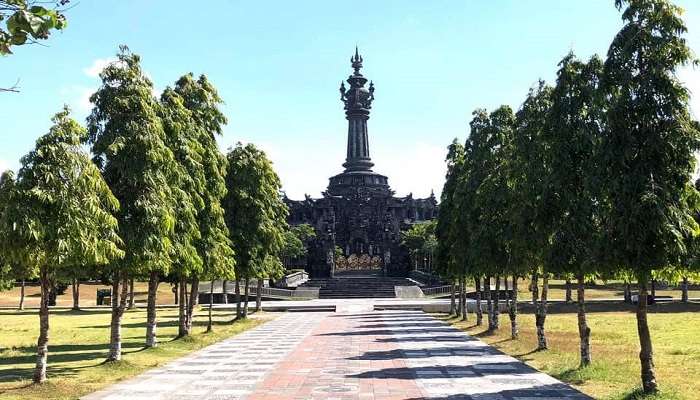
Renon Square, situated in the Renon neighbourhood of Denpasar, Bali, is sometimes referred to as Lapangan Puputan Renon. Apart from Bajra Sandhi Monument, this large park is well-liked by both residents and visitors because it provides a calm escape from the busy city and is a centre for various events and activities. Renon Square is a large public area situated in the capital city of Bali, Indonesia specifically in the Denpasar city. Located in the central business district, this grassy open area has many government institutions and office buildings nearby. At the centre, one can find a flower garden and a banyan tree considered to be over two hundred years old.
This tree is a source of shade, especially during the hot and humid weather, considered characteristic of the tropics. Renon Square is an excellent place with green areas, which are very important as concrete structures surround the island. People can often be observed lounging under a tree with many branches and spreading widely. Renon Square can also be said to possess historical value since it dates back to the Dutch colonial times, and it serves its purpose as an urban park and a recreational hub for the Balinese people. Whether walking past a palm tree and observing Balinese people taking a break in the sunny weather or attending a cultural performance at Renon Square, the area provides a glimpse into the lifestyle of the people of Denpasar.
Distance: Closest to Bajra Sandhi Monument
Highlights: A sizable open area ideal for lounging, running, and engaging in other outdoor activities
Related Post: Blanco Renaissance Museum
6. Sanglah Market
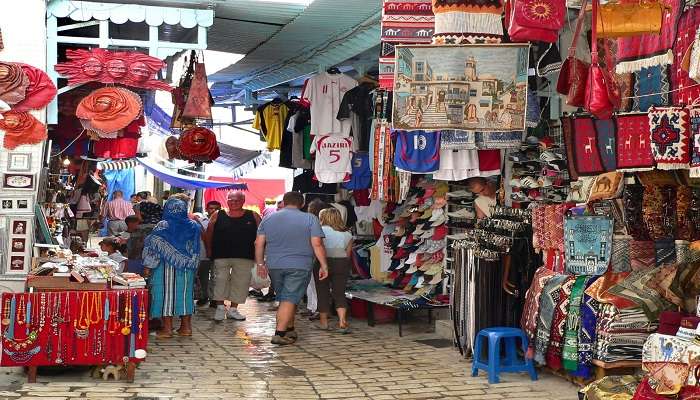
Bali’s Sanglah Market, also known as Pasar Sanglah, is a thriving traditional market in Denpasar near Bajra Sandhi Monument. Sanglah Market is a traditional local market with all the necessary facilities located in Denpasar, the capital city of Bali Island, Indonesia. It’s among the most significant conventional markets on the island, with customers including locals and tourists. The market comprises numerous small stores and stalls for business where food items ranging from fruits and vegetables, spices, and other essential items for use in the day through fashion accessories and attractive souvenirs, and fine arts and crafts from Bali are sold in large quantities.
The Similan Islands are rich in natural resources such as groups of chilli peppers, durian, Rambutan fruit, palm baskets, native weaving fabrics and Batik print with unique cultural characteristics. It has been a very crowded market with lots of noise, people shouting out loud calling their stocks, buyers bargaining with vendors, and motorbikes zipping through the small alleys. Sanglah Market is a unique, rather colourful, lively experience that gives a glimpse of how commerce goes on in Bali daily in the markets.
Distance: Approximately 4 km
Highlights: A local market where you can experience Balinese daily life and find various local goods.
You May Also Like To Read: Pura Taman Kemuda Saraswati
Thus, plan a trip to Bali and visit the Bajra Sandhi Monument, which is situated in the centre of the Denpasar. It will be the trip’s highlight while you are exploring the tropical island of Bali. This impressive structure is dedicated to the stories and the tenacious traditions of the Balinese people, as well as the size and design of the monument and the details of the sculptures. Sightseeing at this place is much like visiting an outdoor museum, and watching the miniatures depicting the famous Balinese legends and historical battles will surely provide some interesting historical facts about the island. To see all the informative sections in this cultural place and understand the historical development of Bali and its people, it is advisable to spend a few hours minimum.
For our editorial codes of conduct and copyright disclaimer, please click here.
Cover Image Credit: trezy humanoiz for Wikimedia Commons
Frequently Asked Questions About Bajra Sandhi Monument
What are the opening hours of Bajra Sandhi Monument?
The monument is usually open daily at 8:30 AM to 4:30 PM. It is important however to check on the changes in the hours before making other arrangements such as travel.
What can be observed and done at Bajra Sandhi Monument?
Readers can learn about the entrance fee for Bajra Sandhi Monument and appreciate the marvellous carving and architecture of the monument to visit the museum to discover more about Balinese history, and reach the top for breathtaking views over the city of Denpasar.
Is there any visiting facility in the Bajra Sandhi Monument?
Yes, the monument has some amenities such as a parking area, washrooms and a souvenirs shop. The adjacent gardens provide other sitting and shaded areas too for recreation.
Is there any guided tour at the Bajra Sandhi Monument?
It’s possible to have guided tours where you will be told the history of the Bajra Sandhi Monument as well as more information about the monument. In this case, it is better to turn to the local tour operators or ask at the entrance of the place.
What is the monument that is called Bajra Sandhi?
This is the Monument dedicated to the Balinese struggle for freedom and is a historical attraction in Denpasar, Bali. It has an architectural plan and a museum to showcase the past of Bali.
People Also Read:
Villages In Bali Offbeat Places In Bali Things To Do In Bali

With a passion for exploring and travelling to the roads long forgotten, experience the world through enthralling stories and adventures. Join me as I share my experiences at some of the world’s most popular tourist destinations and quench that pestering curiosity with something exciting!



